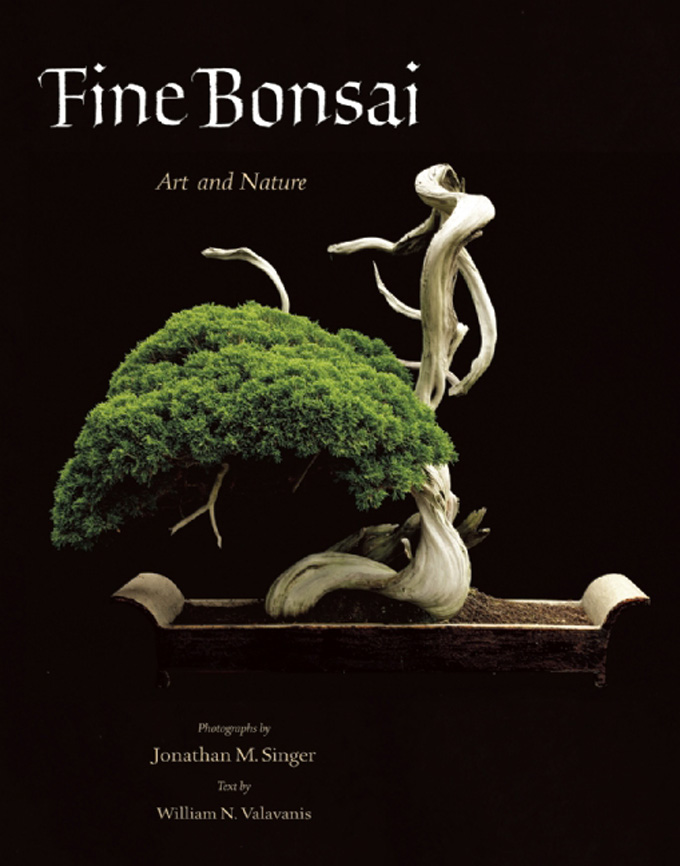 This luminous Tensho Satsuki Azalea belongs to Joseph Noga of Winterville, NC. You can find it and the other photos in this post, in Fine Bonsai, Art and Nature.
This luminous Tensho Satsuki Azalea belongs to Joseph Noga of Winterville, NC. You can find it and the other photos in this post, in Fine Bonsai, Art and Nature.
The finest of the fine
It’s not that these are the finest bonsai in the world and it’s not that they aren’t either. It’s more the combination of top quality bonsai and top quality photography has resulted in some of the finest bonsai photos you’ll see anywhere. In this vein, it’s important to bear in mind that these digital images, though very good, are inadequate. For the full effect and for your complete enjoyment of this magical combination of subject and image, you need to see the book.
 You don’t see too many twin-trunked trees with a sabamiki (hollowed trunk) where the two trunks join. It’s a Chinese hackberry (Celtis sinensis) that originally belonged to Ben Oki and now resides at the Pacific Rim Bonsai Collection, Federal Way, WA.
You don’t see too many twin-trunked trees with a sabamiki (hollowed trunk) where the two trunks join. It’s a Chinese hackberry (Celtis sinensis) that originally belonged to Ben Oki and now resides at the Pacific Rim Bonsai Collection, Federal Way, WA.
 This delightfully unusual Japanese red pine (Pinus densiflora) lives at the Kato family’s Mansei-en Bonsai Garden, Omiya Bonsai Village, Japan. Saburo Kato, the founder of Mansei-en was one of Japan’s most revered bonsai masters.
This delightfully unusual Japanese red pine (Pinus densiflora) lives at the Kato family’s Mansei-en Bonsai Garden, Omiya Bonsai Village, Japan. Saburo Kato, the founder of Mansei-en was one of Japan’s most revered bonsai masters.
 It’s not very often you see a bonsai photographed with a corner of the pot facing you. It looks like there’s a dowel holding up the jin at the top. I wonder if it broke in a storm or perhaps in an accident. The tree is a Sargent’s juniper (Juniperus chinensis, var Sargentii). It’s from The Magician’s (aka Masahiko Kimura) collection.
It’s not very often you see a bonsai photographed with a corner of the pot facing you. It looks like there’s a dowel holding up the jin at the top. I wonder if it broke in a storm or perhaps in an accident. The tree is a Sargent’s juniper (Juniperus chinensis, var Sargentii). It’s from The Magician’s (aka Masahiko Kimura) collection.
 The cover of a truly remarkable work of art. Available at Stone Lantern.
The cover of a truly remarkable work of art. Available at Stone Lantern.
I recently purchased a copy of this wonderfully constructed book. It is of my personal opinion that as well made as the book is and how lovely Bills text descriptions are the book failed to make me go ohhh and ahhh. I found the photography to be a bit under lit in most cases and in others it looked as if the photographer was using a flashlight to light the composition. For as much work that went into this impressive oversized book I wasn’t as fully impressed as I thought I should be. I gaze upon Goshin every single week but almost didn’t recognize it in the book -it wasn’t till I read Bill’s commentary. As an Illustrator I completely understand the use of dramatic light and shading to enhance a composition or invoke a certain mood- however I feel the photography diminished these effects. When I view a bonsai composition I like to see the pot its in, its lower branch structure- I like to see every aspect of the composition well lit and not hidden by shadow. The lighting was a bit too artistic for my tastes-I would suggest in the future to get rid of the flashlight and use some better lighting. Again these are my personal opinions.
Hi Steven,
Thanks for your thoughtful comments. However, I must respectfully disagree with you and with others who voiced similar critiques. The experimentation with lighting, camera angles, time of day, even quality of the trees, is one of the things that I find most compelling and unique about the book. It think this approach helps us to see features and qualities of trees that we normally might miss. When we recognize that a photograph is never the real thing, we can go beyond a purely objective way of seeing to simple perception and feeling, rather than what we are used to or how we think things should be.